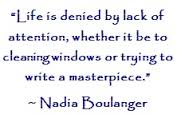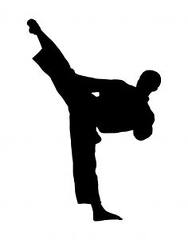All posts by Diane
Give Presence
 As we move through the holiday season and approach the end of the calendar year, people often find themselves in a bit of a frenzy racing from one activity to the next, their heads filled with chatter and a continually growing list of things to do. It is easy to lose ourselves in a flurry of activity and miss out on the purpose behind all the things we tend to do at this time of the year. If you have ever found yourself collapsing in a heap wondering where the time went and feeling depleted rather than filled by the holiday spirit, you know what I’m talking about.
As we move through the holiday season and approach the end of the calendar year, people often find themselves in a bit of a frenzy racing from one activity to the next, their heads filled with chatter and a continually growing list of things to do. It is easy to lose ourselves in a flurry of activity and miss out on the purpose behind all the things we tend to do at this time of the year. If you have ever found yourself collapsing in a heap wondering where the time went and feeling depleted rather than filled by the holiday spirit, you know what I’m talking about.
When your pocketbook has reached the place where there just isn’t a lot more give, take comfort in the fact that there is a gift you can share that transcends all others and won’t cost you a thing. It is the gift of presence, a state that allows us to truly bring out the best in ourselves so that we can do the same for others. The gift of presence is one that allows everyone to receive its benefits, and you can experience it wherever you are — whether in a meeting, running an errand, sitting at your desk, or in a conversation with someone important to you. This practice has the power to transform the way you experience your daily life and what it allows you to create for yourself and others — without really doing anything at all.
Can you recall the last time you felt totally and completely attended to?
Chances are it wasn’t when someone was giving you advice or telling you what to do. It may not have even been when someone was engaging in an activity on your behalf or watching you tear open a gift. And yet when we think of giving something to others our minds often immediately jump to what we can do, say or buy for someone. Many times the best gift we can give someone is that of our presence.
But what exactly is presence?
The word present derives from the Latin past participle praesse meaning “to be before one”, from the roots pra – pre + esse – to be. I believe presence is a state of being that’s achieved when we are truly in the moment, allowing it to unfold without judging it, labeling it, or getting lost in our thoughts about what it means or what we believe should be happening next (or instead). Presence allows us to cut through the clamor of our preoccupations, worries and fears so that our true selves can emerge. It is a gateway through which our intuition and inner wisdom enters and expresses itself. A moment of presence is a state of grace that can produce great insights that help us to truly learn from our experiences, make the most of our opportunities and rise up to our challenges in creative ways. In these moments of presence, we know who we really are and what we are truly capable of.
Have you ever noticed that people tend to match each other’s intensity and tone when they are together? Comments about trivial matters are often matched with similar banter. Expressions of fear or dread often elicit responses that are equally charged, and expressions of anger have a way of provoking reactions that people later regret. In a similar manner, moments of presence when shared with others can evoke powerful responses that can be revealing and transformational. This is because when you are truly present with another human being you create a space that allows that person’s true self to come out as well. This is why the best leaders have learned to become comfortable with silence, to listen more than they talk, and to allow themselves to become instruments that help others to recognize their own greatness – not necessarily through anything that say or do, but rather through moments of presence that are created and shared with others.
So how does one cultivate a moment of presence?
It is really rather simple, though far easier said than done.
(1) The first step is to be still. That’s right. Sit still. I know it goes against everything you were probably taught about getting things done and being useful. But do it anyway. You can practice now, while you read this. Become aware of your breathing, of the space you are sitting in, of the weight of your body and how it feels in this moment. Feel the life inside you and trace it to each part of your body. Listen to the sounds around you. Take a deep breath. Let it out slowly.
 (2) Become aware of your thoughts. Observe the activity of your mind as it continues to process whatever is there– thoughts like, “this is silly, really – I have way to much to do to be sitting here, doing this…” and “I have to remember to call so and so back today,” and “What did my [boss, colleague, friend, etc.] mean when he/she said…”. Recognize that you are not your thoughts, but rather the thinker of your thoughts. Simply watch them parade around, without getting sucked into them. Feel how much bigger you are than all of that. Continue to breathe it in.
(2) Become aware of your thoughts. Observe the activity of your mind as it continues to process whatever is there– thoughts like, “this is silly, really – I have way to much to do to be sitting here, doing this…” and “I have to remember to call so and so back today,” and “What did my [boss, colleague, friend, etc.] mean when he/she said…”. Recognize that you are not your thoughts, but rather the thinker of your thoughts. Simply watch them parade around, without getting sucked into them. Feel how much bigger you are than all of that. Continue to breathe it in.
(3) Step three…. There really is no step three. Simply continue to repeat steps one and two, immersing yourself more deeply into the experience with each breath. You don’t need to do this for an extended period of time, unless you want to. Often even a couple of minutes are sufficient to bring you to a more intense state of awareness and aliveness.
In these moments of presence, you will experience things on a different level – one that allows you to respond from a deeper, wiser part of yourself. And when you are with others, you will bring out that deeper, wiser part of them as well. Presence is incredibly powerful to practice with others. The process is the same, except that you expand your awareness to take in the other person as well. Look into their eyes, and listen to what they are saying. But listen to what they are not saying as well. Presence is more about being than doing. So allow yourself to truly BE with another, devoid of judgments, labels, and agendas. When you listen from this place, you are like water to a thirsty plant, allowing others to open up and soak in needed nutrients. And in this space, they may just find the answers they seek as well – not because you are giving them, but because you have created a space that is illuminating for everyone.
Picture by scottchan.
The Real Meaning of Victory
 Well, I made it through my karate belt test on Saturday. I actually really enjoyed my belt test. Yes, it’s true.
Well, I made it through my karate belt test on Saturday. I actually really enjoyed my belt test. Yes, it’s true.
In last week’s blog post, Overcoming the Illusion of Fear, I wrote about the anxiety I experienced after my last karate belt test that led me to fear and dread the next one. And I also wrote about what helped me get into a mindset that would allow me to finally feel ready to stand in the fear and do the thing I was afraid of. If you would have asked me a year or two ago what victory would have been, I would have told you it was making it through the test without getting hit in the face. And I didn’t get hit in the face, but that’s not what I feel most victorious about.
You would have thought from reading last week’s article that the whole test was sparring and grappling. In fact, I’m told it only lasted a total of four minutes (though it feels like an eternity when you’re in it). The actual belt test in its entirety was five and a half hours long. Yes, that’s right – 95% of my anxiety and fear was about a four minute portion of a five and a half hour test, a fact that was pointed out to me and other karate students in class two days before the test. It was a startling realization. As I reflected on it, I became aware that it’s not the first time I’ve gotten so worked up over something that I poured more of my energy into worry and anxiety than anything else.
“I’ll feel so much better when that presentation is behind me.”
“I just want to get that project done so I can relax.”
“I won’t be able to enjoy myself until I have that dreaded conversation.”
 Do you ever say things like that to yourself? Check the box, and then feel grateful for having checked another box. The trouble with that mentality is that it leads us to withdraw ourselves from the very things that we need to be most present for. We get so attached to the outcomes that we cheat ourselves of the experiences and the real gifts they offer. Sure they’re uncomfortable. Of course we look forward to having them over with. But the real victory is not in winning the trophy, it’s in having played our best game. And to do that, we must be fully present – while the game is being played.
Do you ever say things like that to yourself? Check the box, and then feel grateful for having checked another box. The trouble with that mentality is that it leads us to withdraw ourselves from the very things that we need to be most present for. We get so attached to the outcomes that we cheat ourselves of the experiences and the real gifts they offer. Sure they’re uncomfortable. Of course we look forward to having them over with. But the real victory is not in winning the trophy, it’s in having played our best game. And to do that, we must be fully present – while the game is being played.
We can prepare all we want. We can rehearse. We can plan and practice. And all of that is good. But really, the outcome of any of these things that spin us into a frenzy is directly linked to what we do during the experience itself. We have to detach ourselves from our plans and carefully rehearsed versions of whatever is about to unfold. Because the reality is that we can never fully anticipate what is about to happen. We need to be in the moment, tuning into the people we are with, the things that are being said and done and what we are being moved to do in response that may not have anything to do with what we rehearsed. We need to trust in that part of ourselves that will direct us in just the way we need to go in the moment.
The key benefit of practice and preparation is that we get our minds around the fact that we have everything we need to rise up to any challenge we will be confronted with. In short, we must believe in ourselves and our ability to respond to whatever is taking place even if we’ve never experienced it before.
Merriam Webster defines “victory” as 1: the overcoming of an enemy or antagonist, and 2: the achievement of mastery or success in a struggle or endeavor against odds or difficulties. The true enemy/antagonist in my battle was the part of me that didn’t believe I could handle the karate test, or any test for that matter – the one that just wanted to get it behind me so that I could go onto easier, more enjoyable things. This is the enemy that created the greatest odds and the most horrendous difficulties.
The biggest thing standing in the way of our ability to achieve whatever we endeavor to do is the part of us that keeps us believing we cannot pull it off. True mastery and success will occur for each one of us as we endeavor to rise up in the midst of this opposition and do what is ours to do. And as we do, we will create something we can be truly grateful for – the experience of discovering and unearthing that part of ourselves that can remain calm in the face of any opposition and access the best possible solution in the moment – any moment. This victory is the only kind that is lasting. And each victory of this kind builds on the one that came before.
A toast, to victory! And to every experience, for better or worse, that gives us the opportunity to truly experience it.
I would like to personally thank the Center for Humane Living and every person who is a part of it for enriching my life, and that of others in so many profound ways.
For more on achieving Victory:
The Pinocchio Principle: Becoming the Leader You Were Born to Be 
Checklist image by Rawich.
Jumping silhouette by Biansho.
Overcoming the Illusion of Fear
 Almost exactly two years ago, I had a karate belt test that pushed me beyond my limits. I wrote an article called Tapping Your Reserves that captured what took place as well as the lessons I learned as a result. But reflecting back on that experience now, I realize that in the months that passed, I ended up learning more than I initially realized.
Almost exactly two years ago, I had a karate belt test that pushed me beyond my limits. I wrote an article called Tapping Your Reserves that captured what took place as well as the lessons I learned as a result. But reflecting back on that experience now, I realize that in the months that passed, I ended up learning more than I initially realized.
Here’s an excerpt of that article, depicting that experience:
Waiting outside the dojo adjusting my mouthpiece like a horse trying to acclimate to its first bit, I quietly prepared myself, breathing slowly and deeply. After my name was called, I was ushered into a circle of black belts standing around a plastic red padded floor until I stood face to face with my opponent – one of the toughest, most intense sensei’s I have encountered as a martial arts student. Our heads were swallowed up by the protective foam of our sparring gear, exposing only eyes, cheeks, noses and lips.
After bowing to each other, we began to spar. I threw a few of the punches I’d practiced every week in karate class and managed to get some kicks in. But for every strike I made, it seemed my sensei threw at least three more. I continued to circle, launching a few more tentative jabs here and there. The black belts surrounding us were shouting encouragement, their voices merging into chords of indistinguishable tones. And then I felt a sharp blow to my face. I instinctively curled toward my stomach and felt a burst of fluid that was not yet visible. When the blood appeared, the sparring session was stopped and a hand appeared with a wad of Kleenex in it.
As I cautiously dabbed at my nose and wiped my eyes, someone asked me if I wanted to continue. I heard myself say yes. Squinting through the sweat that was dripping from my forehead and feeling my heart beating in my face, I raised my gloved fists higher and took a few more shots. Before I knew it, I was taken to the ground. I was vaguely aware that there was at least one, maybe two other black belts in the sparring match now. As I grappled on the ground, fatigue set in. I struggled to escape the choke hold, forgetting everything I had learned and feeling like a spider’s prey wriggling and writhing to escape while the grip became tighter. And then, thankfully, that part of the test was over.
I wrote the Tapping Your Reserves article to process that experience and make the most of it. Ironically, despite the insights I gained, in the months that followed I found myself feeling far more fear about what happened than I did on the day that I got punched in the nose. The experience became exaggerated in my mind, a horribly warped version much like the image reflected by a fun house mirror. The sense of accomplishment I enjoyed after having completed the test was replaced by a fixation on what it felt like to be trapped with no recollection of how to escape. I felt the blow to my face over and over again as I replayed the events in my mind. And it was far more painful in my memory than it was in reality.
 What is amusing to me is that often fear like this comes before an event – as I see in my mind’s eye all manner of things that could go wrong and then magnify it until it becomes a mental picture so horrid that I would do anything to avoid it. But this time, I was using a somewhat fictional account of an actual event to work myself into a frenzy that led me to avoid the future based on a past that was more imaginary than real. After all, when given the choice on the day of the test, I decided to jump back in and keep going after getting hit. My hesitance about the whole thing didn’t really set in until after it was over.
What is amusing to me is that often fear like this comes before an event – as I see in my mind’s eye all manner of things that could go wrong and then magnify it until it becomes a mental picture so horrid that I would do anything to avoid it. But this time, I was using a somewhat fictional account of an actual event to work myself into a frenzy that led me to avoid the future based on a past that was more imaginary than real. After all, when given the choice on the day of the test, I decided to jump back in and keep going after getting hit. My hesitance about the whole thing didn’t really set in until after it was over.
As my kids’ team practices and dance rehearsals began to conflict with karate classes, I was secretly a little grateful that shuttling them from school to field to court to studio prevented me from attending with the regularity I once did. God forbid I would be asked to test again – to spar again. No, not an experience I was eager to repeat. Every time anyone referenced sparring in karate class, I felt a shudder go down my spine. The idea of even putting protective gear on made me nauseous. I became overly concerned with playing safe – doing whatever I could to avoid getting hit again. But I knew at some point I would need to get over it and get back in the game.
Gradually I got tired of being scared, of holding myself back, of playing in the shadows. I was still afraid, but found myself growing more and more eager to face those fears and step into them. I began to pay careful attention in the strategy sessions that were being offered. I started to envision a different scenario than the one I was previously playing out in my head. And I even attended a special open sparring class just so that I could put myself in the experience of facing an opponent and replacing my fear with the tiniest shred of confidence I could muster.
A few weeks ago, I received an invitation to test again. I accepted. The test is this Saturday.
I’m nervous. I’d like to be a little more prepared, and I realize that no matter how much I practice, the fear will still be there. But I don’t need to give into it. I just need to stand in its presence without letting it grip and control me. And I think no matter what happens in this test – even if I get knocked out cold or do something incredibly embarrassing, I will be victorious. Because the real battle I am fighting is with myself. And it’s not just a sparring match. It is a metaphor for overcoming resistance (and the illusion it creates) that keeps me from doing what I really want to do in all areas of my life.
In the end, the pain of holding out and playing small became far greater than the physical pain I can recall from the event that provoked the fear in the first place – perhaps far greater than any fear my little mind can conjure up. Enough already. I’m ready to play.
Bring it on, baby.
“Courage is not the absence of fear, but rather the judgment that something else is more important.” ~ Ambrose Redmoon
For more on Overcoming the Illusion of Fear:
The Pinocchio Principle: Becoming the Leader You Were Born to Be 
Skiing Into (and Through) Fear
Surviving and Thriving in Change and Chaos
A Strategy for Overcoming Fear
Karate image by Kriss Szkurlatowski.
Fire head image by Salvatore Vuono.
Shifting From Sabotage To Success
 It has been said that every thought you have has an impact on something. And I believe it. What about the thoughts that fly randomly through your brain – the ones you have little or no awareness of? And what about the thoughts that get stuck in your head, repeating themselves over and over and over…? That’s what this week’s video post is all about. I hope you enjoy it!
It has been said that every thought you have has an impact on something. And I believe it. What about the thoughts that fly randomly through your brain – the ones you have little or no awareness of? And what about the thoughts that get stuck in your head, repeating themselves over and over and over…? That’s what this week’s video post is all about. I hope you enjoy it!
Here’s what I said (and sang) in the video:
A SONG OF SABOTAGE: “I cannot help but feeling that I have so much at stake. So I lock myself inside my head and I just run in place. So many directions, I don’t know which way to go. I’m so busy doing nothing, that I’ve nothing to show. I’ve got a new LOW…”
Lyrics from A New Low by Middle Class Rut
A SONG OF SUCCESS: “When a problem comes along, you must whip it. Before the cream sets out too long, you must whip it. Now whip it, into shape. Shape it up. Get straight. Go forward. Move ahead. Try to detect it. It’s not too late – to whip it. Whip it good.“
Lyrics from Whip It by Devo
“I can’t help feeling like I have so much at stake so I lock myself inside my head and I just run in place.” Do you have a song like this running through your head?
We get songs stuck in our heads and before we know it, they’re playing over and over. It’s really similar to the negative beliefs and doubts and negative things we say to ourselves all throughout the day. And we may not even have any idea what it is we’re telling ourselves until we recognize that we’re just feeling lousy.
When that happens, we can get conscious of what’s at the root of that. And often times, it’s something that we can easily adjust. The only way that I know of to get a song out of my head that won’t go away is to replace it with another song.
So, if you think of that in terms of what we’re saying to ourselves, what’s the song that you need to play inside your head right now? What’s the song that you can play that’s going to make you turn your view around and help you show up in a whole new way?
For more on Shifting From Sabotage To Success:
The Pinocchio Principle: Becoming the Leader You Were Born to Be 
A Strategy for Overcoming Fear
The Tyranny of Should: Chore vs. Choice
Lightening Your Load: Mind Over Matter
Image by digitalart.
My Personal Career Comeback
 Have you ever had a career disappointment that shook you to your core? I did, and it was early in my career. When it first happened, I was bitter, frustrated and scared. But what I ended up learning from the experience was pivotal to my future. And to this day, I am still grateful.
Have you ever had a career disappointment that shook you to your core? I did, and it was early in my career. When it first happened, I was bitter, frustrated and scared. But what I ended up learning from the experience was pivotal to my future. And to this day, I am still grateful.
I know many people out there are enduring all kinds of career shakeups and also know that I am always heartened to hear stories of people who were able to take fairly lousy situations and find a way to benefit from them. It is in this spirit that I share my story with you – (1) The Situation, (2) The Strategy, and (3) Lessons Learned. Please feel free to share your own experiences, advice or questions by clicking on “Add a Comment” above.
THE SITUATION:
My first job after college was at an advertising agency. Having yet to arrive at the realization of what I wanted to do with my life, I took the job because it had elements of what I studied in college: English, business and communication – and because it sounded fun and interesting. I started as an administrative assistant with the promise that it wouldn’t be long before I would be promoted into something a bit more substantive.
Turns out advertising just wasn’t my thing. The work itself didn’t pique much interest in me, but I was intrigued with the organization and the people in it. Turnover was high, morale was low, and the customer was an afterthought. I knew that all that could be changed – that something could be done to allow people to feel more alive in their jobs, to ensure that the customer was happy, that the company was growing and profitable. So I got to work talking to people. I interviewed smart, ambitious entry level personnel, who felt discouraged and overlooked when the jobs they were working toward were filled by people from outside of the company.
I talked to new creative staff and account executives who came in and hit the ground running, knowing little about the agency or its customer. I spoke with seasoned executives who lamented that no one seemed to care about what was most important anymore. I integrated all their insights, ideas and suggestions with my own observations and created a proposal to implement a program that would allow seasoned people to train and mentor newer folks, better integrate with the customer, and grow the business from within.
Knowing little about corporate politics, I went straight to the VP of Operations with my proposal to create the program and allow me to run it. He listened intently, asked several questions, and arranged subsequent meetings with others in the company. It wasn’t long before a position was created. My boss at the time, who wasn’t impressed with my lack of passion for being an administrative assistant or the fact that I went over her head with my proposal (which I never even told her I was working on) was outraged.
She called upon her networks to put a stop to things. A few days later I was told that while the company was going to create the position and launch the program I proposed, because of all the controversy, they could not allow me to head it up. I was crushed. I remember walking across the agency’s glossy floors and out the tall glass double doors of the building, burning with animosity, rage, and frustration at the seeming injustice of it all.
THE STRATEGY:
 In the weeks that followed my indignant resignation, the anger and bitterness gradually released me from its grip and I began to feel a sense of calm clarity. I was onto something here. Maybe there was a way that I could work with corporations, organizations and people themselves to bring out their latent talent and harness it in a way that could contribute to a common goal. I went to the local bookstore and bought a copy of What Color is Your Parachute and dedicated myself to doing the soul searching exercises there and taking action to learn about work and potential opportunities that were more aligned with my core talents, interests and passions.
In the weeks that followed my indignant resignation, the anger and bitterness gradually released me from its grip and I began to feel a sense of calm clarity. I was onto something here. Maybe there was a way that I could work with corporations, organizations and people themselves to bring out their latent talent and harness it in a way that could contribute to a common goal. I went to the local bookstore and bought a copy of What Color is Your Parachute and dedicated myself to doing the soul searching exercises there and taking action to learn about work and potential opportunities that were more aligned with my core talents, interests and passions.
Somewhere in my search I discovered that in many corporations there was a department called organization development that employed people to do the kind of things I tried to do at the advertising agency, and more of the kind of work that truly excited and inspired me. I began to ask around and find people who actually did these jobs. Some of them were people that friends of mine knew. I began to interview them, asking about how they got started, what they loved and didn’t love so much about their jobs, and what advice they would have for someone like me who wanted to break into the field. At the end of every interview, I asked for the names and numbers of three more people they would recommend I speak with. I ended up building a pretty great network and it wasn’t long before one of the people I spoke with called me with an opportunity to do an internship at a local hospital in their organization development department.
I was thrilled and ended up learning the ropes from incredibly talented mentors who allowed me to take part in projects that were intriguing, challenging and incredibly rewarding. I was an intern for less than a year before I was offered a permanent position doing satisfying and empowering work I didn’t even realize was out there when I was scratching my head back in college trying to answer the question of what I wanted to do with my life. And each subsequent opportunity I have had has helped me further refine and hone what I love to do into a career that lights me up allows me to continue to grow and evolve.
LESSONS LEARNED:
 Among the many things I learned from that experience are the following:
Among the many things I learned from that experience are the following:
- That defining moment led me on a search that would allow me to find ways to do more of the work that beckoned to me. It launched a chain of events that has led me to learn more about myself and make the most of experiences that would further prepare me for the work that I do now. And I am grateful – so completely and utterly grateful – that it happened, though at the time I thought it was the worst possible thing.
- Sometimes the biggest disappointments are actually precursors to the most amazing opportunities. I learned not to allow my frustration, anger and sadness (even if it is justified) to blind me to what is knocking on my door. I learned to let myself be angry for a short period if I need to and then challenge myself to figure out what positive action to take to get closer to where I really want to be. I try to focus my energy and attention into moving toward something I want rather than away from something I don’t want.
- It’s okay if I don’t know exactly what I want to do with my life. This experience taught me that anything I do will prepare me for whatever I’ll do next. I may not know exactly the kind of work that is my best fit until I see what is out there and notice what excites me and what doesn’t. If I can find a way to love the job I’m in, I will benefit by learning more about myself and developing skills that I will be able to use anywhere I go.
- I realized that I don’t necessarily have to leave my job or the company I work for to do something that I love. If I pay attention to what intrigues me and take action to align my natural curiosities and talents with the unmet needs I see wherever I am, it’s possible that the solutions I propose could land me a whole new role – one that is custom designed for me, even when there are no jobs posted on the company’s internal job board.
- I learned the importance of being willing to take a risk and let go of needing my career to turn out exactly the way I think it should. Even though I initially thought the risk I took ended in failure when I didn’t get the position I helped create, it ended up opening my eyes to opportunities I didn’t even know existed. It prepared me for a career in an organization that was far more aligned with my interests and values.
Future photo by graur razvan ionut from FreeDigitalPhotos.net.
Light bulb photo by Pixomar from FreeDigitalPhotos.net.
Open mind photo by Idea go from FreeDigitalPhotos.net.
For more on Career Comebacks:
The Pinocchio Principle: Becoming the Leader You Were Born to Be 
Navigating Sudden Change
 Ever notice that just when you get comfortable, life has a way of shaking things up? Some people seem to enjoy change more than others. Most of us prefer to be the ones doing the changing – it brings newness along with a sense of control – we are at the helms, steadfastly steering our ships. But imagine if you will, that a massive wave summoned by a hurricane has ripped the captain’s wheel right off the ship and you are left clinging to something that no longer has any power. The tighter you grip it, the less energy you have to deal with your circumstances in a way that will truly serve you (and everyone around you as well).
Ever notice that just when you get comfortable, life has a way of shaking things up? Some people seem to enjoy change more than others. Most of us prefer to be the ones doing the changing – it brings newness along with a sense of control – we are at the helms, steadfastly steering our ships. But imagine if you will, that a massive wave summoned by a hurricane has ripped the captain’s wheel right off the ship and you are left clinging to something that no longer has any power. The tighter you grip it, the less energy you have to deal with your circumstances in a way that will truly serve you (and everyone around you as well).
At times like these, we often pray for the storm to pass – for things to revert back to the way they were – or for a specific course of events that we believe would be life’s perfect solution. These solutions are based on what we think we know – which is largely a product of what we have already seen and experienced. And relying upon the patterns and strategies that worked for us in the past is often inadequate for our present and emerging challenges.
The world is changing and so are we.
We tend to strive for comfort and familiarity, even when what’s comfortable isn’t necessarily effective or even satisfying anymore. We wish and pray that the chaos be removed and order be restored. But often life’s little disturbances are exactly what we need to reach our true potential and escape complacency. Perhaps as Eckhardt Tolle wrote in The Power of Now, “…what’s appears to be in the way IS the way.”
 Stormy seas (and life’s sudden surprises) have a way of testing our resolve and our resiliency. Pressure brings out our extremes – for better or worse. And fear does funny things to people. At its worst, it produces panic – a physical state that literally disables the brain’s ability to think clearly. At one extreme a person is frozen by fear and at the other he will thrash about like a drowning victim who pulls his rescuers under the water with him. The key to surviving a seeming assault of this kind is learning to relax and stay calmly aware of our surroundings so that we can identify and creatively utilize the resources at our disposal.
Stormy seas (and life’s sudden surprises) have a way of testing our resolve and our resiliency. Pressure brings out our extremes – for better or worse. And fear does funny things to people. At its worst, it produces panic – a physical state that literally disables the brain’s ability to think clearly. At one extreme a person is frozen by fear and at the other he will thrash about like a drowning victim who pulls his rescuers under the water with him. The key to surviving a seeming assault of this kind is learning to relax and stay calmly aware of our surroundings so that we can identify and creatively utilize the resources at our disposal.
One of the most critical resources in our control when all else seems beyond it is our perspective. The way in which we view things determines the story we tell ourselves about what’s happening, which directly influences the responses we will have. If we believe we are helpless victims at the mercy of something that seeks to destroy us, we will become bitter, resentful and apathetic. In this state our true power remains dormant. We collude with our view of reality to create a condition that validates our doomsday stories and sink even deeper into the abyss. Those who try to rescue us from our self imposed paralysis risk being dragged beneath the current created by our own negativity.
If, however, we view our predicaments as adventures and see them as opportunities to give things all we’ve got, we reach deeply within ourselves and tap reserves of courage, wisdom and ingenuity we never realized we had. In the proverbial belly of the whale we find our inner grit and creatively rise up to life’s challenges in ways that transform us and everyone around us as well. We become the heroes of our own stories.
Regardless of who you are and what you do, there will come a time when the plateau you have been walking upon takes a steep turn in one direction or the other and you will be required to do something that stretches you beyond your usual way of doing things.
Perhaps it will be in your career. The work that fulfilled you at one point in your life may no longer be enough. You might find yourself doing something very well but suddenly devoid of the gusto you once did it with. It could be the company you keep – people who at one time shared your interests and passions but who you suddenly find yourself no longer wanting to spend a lot of time with. Maybe it will be your lifestyle. The objects and material possessions you that once gave you joy could one day feel more like clutter or distractions. These things become like shells that the hermit crab has outgrown. The crab must release its previous home and step bravely and vulnerably into the unknown in order to find something more spacious.
 The quest for a new shell and even the new shell itself may feel daunting, clumsy and overwhelming. But the act of letting go of the old to make room for the new allows us to evolve and realize our true potential. Anything less will ultimately become imprisoning. When we allow ourselves room to grow, life’s little and big disturbances are not so daunting. We know there is more to us than meets the eye and finally step into our own greatness. And as we do this for ourselves, we model the way for others to do the same.
The quest for a new shell and even the new shell itself may feel daunting, clumsy and overwhelming. But the act of letting go of the old to make room for the new allows us to evolve and realize our true potential. Anything less will ultimately become imprisoning. When we allow ourselves room to grow, life’s little and big disturbances are not so daunting. We know there is more to us than meets the eye and finally step into our own greatness. And as we do this for ourselves, we model the way for others to do the same.
 The above article contains excerpts from my new book, The Pinocchio Principle: Becoming the Leader You Were Born to Be, available on Amazon.com and BarnesandNoble.com.
The above article contains excerpts from my new book, The Pinocchio Principle: Becoming the Leader You Were Born to Be, available on Amazon.com and BarnesandNoble.com.
For more on Navigating Sudden Change:
Ship photo by 1971yes from Bigstock.com.
Hermit crab photo by porbital from FreeDigitalPhotos.net.
Skiing Into (and Through) Fear
 Have you ever found yourself in a situation where you suddenly realized you were in way over your head? Maybe you weren’t sure you were ever going to get through it and had no idea what to do. This week’s video post is about an experience I had like that – on the ski slopes. It’s something I remember whenever I find myself in a jam, or consumed by fear or worry. I hope you enjoy it!
Have you ever found yourself in a situation where you suddenly realized you were in way over your head? Maybe you weren’t sure you were ever going to get through it and had no idea what to do. This week’s video post is about an experience I had like that – on the ski slopes. It’s something I remember whenever I find myself in a jam, or consumed by fear or worry. I hope you enjoy it!
Here’s what I said in the video:
A few years ago I had the opportunity to go snow skiing, which I love to do and hadn’t done in years. I couldn’t wait to hit the slopes, and I knew I needed to start slowly because it had been a really long time. So I started off with easy runs and it wasn’t long before I said, “The heck with this, I’m going straight for the black run.”
I picked a run and got to the top of the hill. After pushing myself off and getting about a third of the way down I realized, “Oh my God, this is SO over my head!” There were moguls everywhere. I’m talking about three foot in diameter and about three foot high little hills — all next to each other.
 To make things worse the slope of the hill was almost vertical. It was awful. I got about a third of the way down the hill and realized this was a mistake. I looked up and knew I couldn’t climb back to the top. And just at that moment this fog rolled in — fog so thick I felt like I could grab it and hold it in my hand. I couldn’t see more than three feet in front of me.
To make things worse the slope of the hill was almost vertical. It was awful. I got about a third of the way down the hill and realized this was a mistake. I looked up and knew I couldn’t climb back to the top. And just at that moment this fog rolled in — fog so thick I felt like I could grab it and hold it in my hand. I couldn’t see more than three feet in front of me.
I panicked. All I wanted to do was get down the mountain. So I thought, “OK. I’m just going to go for it.” I pushed off and plop, came smacking down to the ground, skis flying in different directions. And then it took me 20 minutes to find them because I couldn’t see anything. I finally got my skis back on and tried it again and thwhap — same thing.
I thought, “I just have to figure this out from where I’m at.” I realized just about all I could see was the mogul in front of me and if I could just ski around the edge of the mogul and bend my legs in such a way that they absorbed the shock, I was able to get around that mogul and stop. Then I could look at the next mogul, ski around the edge of that and stop. I was making some progress. And then I looked down toward the end of the mountain and guess what? Totally wiped out again.
I realized, “If I’m ever going to make it down this mountain I’m going to have to forget about reaching the bottom and take one mogul at a time and trust that I’m going to know exactly what I need to know how to make it — one mogul at a time.”
What I learned from that is to get out of fear you can’t go back into the past, and you can’t get preoccupied with what needs to happen in the future. You have to stay right in the moment and take it one moment at a time. And when you do, you will have everything you need to get through it.
You have everything you need in this moment.
You’ll have everything you need in the next moment too.
BE where you are.
Mountain photo by Sarah Nicholl from Dreamstime.com.
Surviving and Thriving in Change and Chaos
What if the only thing standing in your way of perfect peace, true productivity and the satisfaction of living a life of purpose – was your thinking?
 Many of us are experiencing a great deal of pressure, anxiety and sudden change. Jobs are tenuous, organizations are restructuring, and it might feel as though life itself is turning upside down. Frustration and turmoil is a common response to this kind of uncertainty and disorientation. It can lead to exhaustion and hopelessness. But consider this as you think about the things in your life and career that may feel as though they are spinning out of control…
Many of us are experiencing a great deal of pressure, anxiety and sudden change. Jobs are tenuous, organizations are restructuring, and it might feel as though life itself is turning upside down. Frustration and turmoil is a common response to this kind of uncertainty and disorientation. It can lead to exhaustion and hopelessness. But consider this as you think about the things in your life and career that may feel as though they are spinning out of control…
What if everything is perfect just the way it is?
No, I haven’t gone off the deep end. Bear with me here… One of the key attributes embodied by extraordinary leaders in all walks of life is encapsulated in the word “responsibility” – not just in a moral or ethical sense of being accountable for our actions, but also – and perhaps just as essential in times of change and chaos – remembering that there is wisdom in recognizing that we have the ability to choose our response – and that the response we choose will have a resounding impact on ourselves and everyone around us.
The greatest of change agents start by recognizing what they have to work with before they can create change that will be sustained. They assess their environment to determine what the best entry point for that change is before they make their move. They don’t waste their time worrying about things that are truly out of their control, like changing the weather. Instead, they focus their attention and energy on those things that they do have the ability to influence and start there. The greatest of leaders know that the most powerful and sustainable change must start from within themselves.
 The thing that fascinates me about a seemingly chaotic state of affairs is not so much what is happening, but the stories we are telling ourselves about what it means and the impact those stories are having on the way we are responding to it. When we react to things with fear, we end up amplifying that which we are afraid of and adding to the anxiety. Our fears drive us to act in ways that keep us from acting on our intuition and finding the answers that will truly serve us. Sometimes, we end up behaving in ways that make our fictional stories become real.
The thing that fascinates me about a seemingly chaotic state of affairs is not so much what is happening, but the stories we are telling ourselves about what it means and the impact those stories are having on the way we are responding to it. When we react to things with fear, we end up amplifying that which we are afraid of and adding to the anxiety. Our fears drive us to act in ways that keep us from acting on our intuition and finding the answers that will truly serve us. Sometimes, we end up behaving in ways that make our fictional stories become real.
As an example, when you tell yourself a story about what is happening that leaves you feeling threatened, you may find yourself closing up and treating others with suspicion and mistrust. The way you are behaving toward people may well provoke a response in them that appears to validate your fearful story. However, in this scenario, it is very likely that their behavior is more of a reaction to the actions your story led you to take than anything else.
 Our fearful stories are like the viruses we protect our computers from. These nasty viruses are often embedded in emails that pique our curiosity or rouse our fear. When we unwittingly activate them, they spread often uncontrollably and we risk passing them to the computer of our friends, associates and countless others. The viruses corrupt our systems until they no longer function effectively. Like computer viruses, our stories have a way of spinning us out of control and interfering with our ability to rise up to our challenges to find the opportunity that is always there waiting for us to discover and leverage it.
Our fearful stories are like the viruses we protect our computers from. These nasty viruses are often embedded in emails that pique our curiosity or rouse our fear. When we unwittingly activate them, they spread often uncontrollably and we risk passing them to the computer of our friends, associates and countless others. The viruses corrupt our systems until they no longer function effectively. Like computer viruses, our stories have a way of spinning us out of control and interfering with our ability to rise up to our challenges to find the opportunity that is always there waiting for us to discover and leverage it.
Our rational minds want answers and security. They need to figure everything out and almost automatically occupy themselves with trying to sort through data to arrive at conclusions. The problem is that our minds are plugging imaginary variables into the equation that end up further exacerbating the anxiety we are already experiencing. When they are done with one variable, they plug in another and the churning continues, leaving us with an uneasiness that keeps us on edge.
In the grip of this madness, sometimes the best thing you can do is indulge your mind with a variable that will allow it to do its thing. Go ahead and plug in the worst case scenario. If the worst possible thing happened, what would you do? Alloy yourself to sit with that question for awhile. Let the fear move through you and keep asking the question, what would I do that would allow everything to be OK? If you sit long enough with your question, you will arrive at some workable alternatives and reconnect with that part of yourself that is strong, resourceful and resilient.
Armed with the knowledge that you will be OK even if the worst possible thing happens, you can come back into the present and recognize your fearful thoughts for what they are – fearful thoughts. One of the best pieces of advice I ever got, which I pass along frequently is don’t believe everything you think.
In the present moment, devoid of your stories about variables that are truly unknown, you are OK. And when new events begin to unfold, if you stay in the moment and access your inner wisdom, you will know exactly what you need to do – or not to do – to be OK then too. And as you go about your daily life in this way, your calm resolve will permeate your interactions with others and through your example, you will help others to rise up to their challenges in ways that unearth the greatness in themselves as well.
 The above article contains excerpts from my new book, The Pinocchio Principle: Becoming the Leader You Were Born to Be, available on Amazon.com and BarnesandNoble.com.
The above article contains excerpts from my new book, The Pinocchio Principle: Becoming the Leader You Were Born to Be, available on Amazon.com and BarnesandNoble.com.
For more on Surviving and Thriving in Change and Chaos:
The Pinocchio Principle: Becoming the Leader You Were Born to Be
Finding Your Answer In the Midst of Chaos
Photo #1 by Kirill Zdorov from Dreamstime.com. Photo #2 by Valeriy Khromov from Dreamstime.com.
A Simple Little Shift
 What’s not working in your life right now? Does it have you spinning into a bit of a tizzy? This week’s video features a story that might provide insight and inspiration to finding the solution you seek – by simply looking at your challenge again, with new eyes. I hope you enjoy it!
What’s not working in your life right now? Does it have you spinning into a bit of a tizzy? This week’s video features a story that might provide insight and inspiration to finding the solution you seek – by simply looking at your challenge again, with new eyes. I hope you enjoy it!
Here’s what I said in the video:
This clock belongs to a dear friend of mine, and she told me a story the other day that was just so enlightening to me. She gave me permission to retell it.
She loves this clock, just loves it. It matches her office beautifully. She has a couple of brushed steel lamps [that match], and it’s the perfect size, and she loves to look at it. But one day it stopped working.
So she went to put in new batteries and to her incredible disappointment, after she put the batteries in it, the clock still didn’t work. She wanted to have something in her office that was as beautiful, if not more beautiful, than this clock. So she did what any of us would do when we really love something enough that we want to replace it or replicate it. She drove all over town looking for a clock that was like this one — store after store after store. And finally she found one that wasn’t quite the same, but it would do.
So she brought it home and put the batteries in, and guess what — that clock didn’t work either! So she opened it up to take the batteries out and she realized, wait a minute – a light bulb went on in her head.
She went she got her old clock that she loved so much and thought she would try this again. So she opened the clock and put the battery in the opposite way – lo and behold it worked again.
I love this story, because it is so representative of we tend to do when something isn’t working. We run all over the place, rack our brains, and sometimes go to great lengths and great expense trying to come up with a solution, when all we needed to do was make a simple little shift using what we already have right in front of us.
Sometimes all you really need is a simple little shift.
Broken glasses picture by Edward Phillips from Dreamstime.com.
Getting What You Really Want
 “What do you really want?” I often ask my clients. “What do you really want?” I often ask myself this too.
“What do you really want?” I often ask my clients. “What do you really want?” I often ask myself this too.
“I want things to go my way. I want to come out on top. I more wins and less losses. I want my problems to go away. I want to be profitable. I want to be successful. I want to be respected.”
These are some of the answers that come back to me when I ask that question of myself and/or others.
“OK. What would that give you?”
“What do you mean, what would that give me? It would give me what I want.”
If people aren’t actually saying that, there’s a good chance they are at least thinking it.
“So, if you got what you think you want, what would that give you?” I ask again.
“Oh. I don’t know. Peace of mind, I guess. Satisfaction. Happiness. A feeling that all is right in the world.”
“What if you could have that now?”
“Great. Sign me up.”
What if it really were that easy? Have you ever noticed that the quality of your day is a direct reflection of your thoughts? If we go into situations believing that we know exactly what must happen in order to achieve the state of satisfaction we want, we are placing conditions on a state of mind that is readily available to us anytime.
“Huh?”
Say you are about to go into a high pressure meeting. You have your agenda. You know what you need to do to come out on top. You believe that things must go a certain way in order for that to happen. You want to win, and you want to be respected. Anything less is unsatisfactory. Your mind is creating a situation where in order to win, people must bend to your will. And potentially, someone might have to lose. If things don’t go exactly the way you envision them, you will be disappointed. And if they do, someone else is likely to feel disappointed, or at the very least disrespected. The satisfaction and happiness you were seeking with a “win” is likely to fade quickly, leading you to believe you must get another “win” to sustain it.
 What if you go into that same situation with a different goal, or intention? What if, instead of having everything figured out and sealed up front, you go in with the desire to agree on a solution that will be in the best interest of all parties — even if that solution is something you haven’t already considered? Your mind will begin to entertain the thought that there could actually be a situation in which everyone wins, including you. You will ask different questions. You will listen more intently. You will be more genuinely interested in what others have to say, because they are an important part of your solution. You will show respect to others, and in so doing become worthy of their respect.
What if you go into that same situation with a different goal, or intention? What if, instead of having everything figured out and sealed up front, you go in with the desire to agree on a solution that will be in the best interest of all parties — even if that solution is something you haven’t already considered? Your mind will begin to entertain the thought that there could actually be a situation in which everyone wins, including you. You will ask different questions. You will listen more intently. You will be more genuinely interested in what others have to say, because they are an important part of your solution. You will show respect to others, and in so doing become worthy of their respect.
What if you could take it a step further? What if you could hold the intention of allowing everyone to win in your mind before you even stepped into that meeting? What if as you began to create the ideal solution you did so with the knowing that everyone will walk away from that meeting feeling better than they did before it started? Could you feel the satisfaction of a pleasing solution before it has even materialized? And if you did, imagine what you would bring to that meeting. A quiet confidence. Faith. Trust. Patience. Confidence in the wisdom of the group. You may help them to consider the potential of a solution as a group that they didn’t previously realize was possible.
We are conditioned to believe that we have to do something in order to get that final end state we all want — something like get our way, accumulate things, prove ourselves, make a lot of money, etc. But what if the success equation were flipped? What if we started out with the state of mind that we most desire? From that state of mind, what actions would we choose?
“What do you really want?”
Ask yourself that question now, with regard to whatever your mind is occupied with.
“What would that give you?”
See if you can take it to a higher level — one that allows everyone involved to benefit in some way.
Can you imagine what that would be like? Can you feel the ultimate end state you want as though it has already happened, even though you have no idea how it will come to pass? Can you rest in the certainty that things will happen in everyone’s best interest?
Let your actions flow from the state of mind you wish to achieve. Over time, you’ll realize that instead of having to see it to believe it, what you see will be a direct reflection of what you believe. Allow yourself to believe in the highest possible good, and you will work miracles in your life and those of everyone around you as well.
For more on Getting What You Really Want:
The Pinocchio Principle: Becoming the Leader You Were Born to Be 
Seven Powerful Lessons for Living that I Learned by Writing a Book
Why Goals Will Only Get You Part Way There — and How to Bridge the Gap
Lightening Your Load: Mind Over Matter
Priorities, Productivity and Perspective
Getting Connected ~ What Intuition and the Internet Have in Common
Eye image by Ciprian Florin Dumitrescu from Dreamstime.com.
Thoughtful image by Anatoly TIplyashin from Dreamstime.com.
